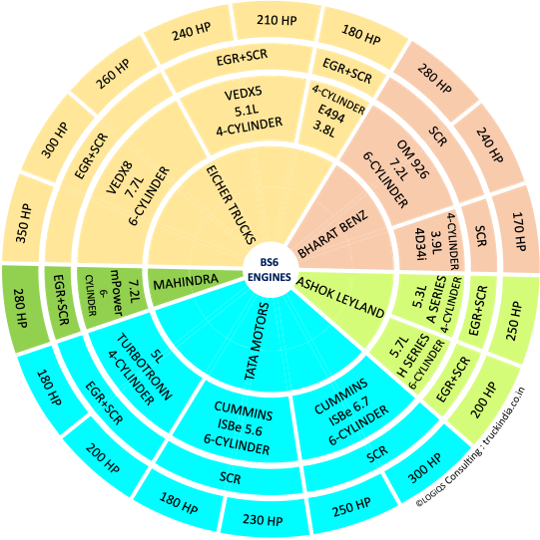
One of the most powerful consideration by a medium & heavy commercial buyer is the brand of engine the vehicle is getting powered with. There are set of customers who look for the time tested & proven reliability, there are a few customers who consider horse power the engine is generating for their application needs and then there are customers who seek new technologies. The selection of engines have become ever so difficult in BS6 as there are few OEMs who have replaced their BS4 engine and at the same time there are few OEMs who have upgraded their engine to meet the BS6 emission norms. All these changes have led to a complex market matrix of different vehicles with different engine brands, sizes, cylinders, power-torque & EGR+ SCR or pure SCR configurations.
In the paragraph below we will quickly discuss the configuration matrix of engines offered by different OEMs and how exactly they influence the vehicle performance.
Engine Size- Expressed in cubic capacity (cc) or litres (L). M&HCV range of trucks, tippers & tractor trailers now a days are full of multiple engine sizes. In M&HCV one of the engine is as small as just a 3.8 litre and on the other hand there is one as gigantic as 7.7 litre. Traditionally smaller engines used to be known for their fuel efficiency with limited acceleration and load pulling ability, whereas bigger size engines were known to be the real performance driver for faster turnaround time & higher load pulling but lower fuel efficiency. However this traditional perception about engines are diminishing quickly as we are seeing BS6 engines which are though compact but are able to generate huge amount of power. Similarly there are bigger engines which are offering excellent fuel economy along with acceleration & load pulling performance.
Engine cylinder- There was a time when M&HCV segment used to be completely driven by 6 cylinder engines, however with advancement of technology in BS6, even 4 cylinder engines are getting widely accepted. 6 cylinder engines are regarded as more reliable under heavy duty applications with lower NVH (Noise , vibration & harshness ) characteristics, whereas 4 cylinder engines are known for their fuel economy for applications that are not so demanding in terms of load & gradient.
Power output- With BS6 not only the range of power has widened , but even the power nodes too have increased. There are engines with 170HP to 350 HP in M&HCV segment. Higher the horse power is, better the acceleration & speed would be, even with higher loads. But not all applications demand very high power, what one has to see while deciding for power is : power to weight ratio. Availability of different power nodes in the market allows the users to choose the most optimum powered vehicle for their application needs.
Torque output- Engine torque impacts ability to pull load, higher the torque better the engine’s load pulling ability will be. Almost all the OEMs in BS6 have increased their engine torque for that purpose, in case if it was low during BS4.
RPM- Lower is better. What it means is that drivers are not required to deep press the accelerator pedal for achieving faster pick up, higher load pulling & attaining top speeds. Lower engine RPMs also helps in enhancing fuel mileage and on a longer run, they help in increasing engine life too. If the maximum torque output is achieved at lower RPMs and in a wider bandwidth they are called flat torque curve. For example 920 Nm @ 1200-1800 RPM is a flat torque curve whereas 920 Nm @ 1400 RPM is called peak torque point. Flat torque curve helps in maintaining continuous higher pulling within the RPM bandwidth. With this phenomena the need for frequent gear downshift reduces considerably, which thereby helps in achieving higher fuel efficiency, longer clutch-gear life and enhancing driving comfort. Peak torque at times is considered useful for very sluggish operations like in mines, farm lands etc.
EGR & SCR- Exhaust gas recirculation (EGR) & Selective catalytic reduction (SCR) technologies help in achieving BS6 norms. . EGR enabled engines (commonly known as EGR+SCR or MidNox) for BS6 reduces AdBlue consumption as the technology ensures lower NOx formation inside the engine, whatever the lower volume of NOx produced by engines are treated in the exhaust line with SCR system. In non EGR engines the NOx formation happens in larger volumes therefor it is entirely up to the after treatment system i.e. SCR to reduce NOx by involving higher quantity of AdBlue during the chemical reaction. Non EGR or pure SCR technology helps in enhancing engine performance in terms of fuel efficiency & engine power-torque output.
Truckindia will release a detailed article on EGR & SCR technologies very soon.
The engine chakra or the engine pie published by TruckIndia is there to help all the stakeholders of M&HCV as a ready reckoner for keeping a track on various engines available in the industry.
Please feel free to write us for any further query : admin@truckindia.co.in
© 2020 - 2022 LOGIQS CONSULTING.